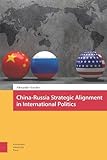China-Russia strategic alignment in international politics /Alexander Korolev.
Material type: TextPublication details: Amsterdam : Amsterdam University Press, (c)2022.Description: 1 online resourceContent type:
TextPublication details: Amsterdam : Amsterdam University Press, (c)2022.Description: 1 online resourceContent type: - text
- computer
- online resource
- 9789048552733
- 9048552737
- DS740 .C456 2022
- COPYRIGHT NOT covered - Click this link to request copyright permission: https://lib.ciu.edu/copyright-request-form
| Item type | Current library | Collection | Call number | URL | Status | Date due | Barcode | |
|---|---|---|---|---|---|---|---|---|
 Online Book (LOGIN USING YOUR MY CIU LOGIN AND PASSWORD)
Online Book (LOGIN USING YOUR MY CIU LOGIN AND PASSWORD)
|
G. Allen Fleece Library ONLINE | Non-fiction | DS740.5.8 (Browse shelf(Opens below)) | Link to resource | Available | on1328031203 |
Includes bibliographies and index.
Frontmatter -- Table of Contents -- List of Figures and Tables -- Acknowledgments -- 1 Introduction -- 2 The Ordinal Model of Strategic Alignment -- 3 Military Cooperation: Approaching Alliance -- 4 Alignment Incentives: The Three Balances -- 5 Robustness Check: Economy and Diplomacy -- 6 Comparative Mapping: US-India and China-Russia Alignments -- 7 Conclusion -- Index
Post-Cold War China-Russia strategic cooperation has displayed significant development and become an increasingly important factor in contemporary international politics. However, there has been no theory-grounded framework and corresponding measurements that would allow an accurate and systematic assessment of the level of China-Russia alignment and its progress over time. How closely aligned are China and Russia? How to define and measure strategic alignments between states? This book bridges area studies and International Relations literature to develop a set of objective criteria to measure and explain the development of strategic alignment in post-Cold War China-Russia relations. It establishes that on a range of criteria, China-Russia alignment is moving towards a full-fledged alliance. It is solid and comprehensive and continues to show a consistent incremental upward trend. There are strong structural incentives for furthering the China-Russia alignment, and there is little that might hinder the effective functioning of a China-Russia alliance. The alignment framework developed in the book can be applied to other cases of interstate strategic cooperation to facilitate comparisons between different strategic alignments.
COPYRIGHT NOT covered - Click this link to request copyright permission:
There are no comments on this title.
